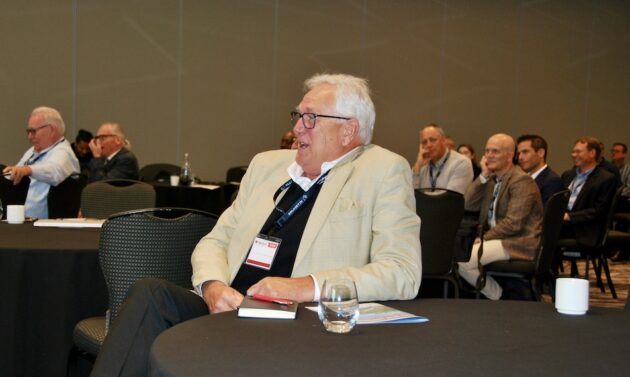The Wood Pellet Association of Canada’s annual conference began with an unusually sentimental note this year: a tribute to the “godfather of wood pellets,” John Swaan.
This year marks a quarter century since Swaan orchestrated the world’s first bulk shipment of wood pellets from his B.C. pellet mill to a customer overseas. In opening remarks to the conference, association past-president and senior Drax executive Vaughan Bassett shared a summary of Swaan’s industry origin story, first told by FutureMetrics’ Hannah Campbell.
The story was followed by a tribute video in which WPAC executive director Gordon Murray, along with a handful of other partners and friends, shared their thoughts on John’s pioneering role in the pellet industry. An emotional Swaan took to the podium to express his thanks.
“It’s an honour to be singled out,” he told the conference crowd. “It took a village… I’m very proud to be involved in helping seed some milestones that have come along.”
Twenty-five years later and the pellet industry is thriving coast to coast in Canada, providing a market for low value sawmill and forestry residuals.
Markets and Prices
FutureMetrics’ president William Strauss and Arugs Media’s Erisa Senerdem took to the stage to share the global outlook for pellet markets and prices.
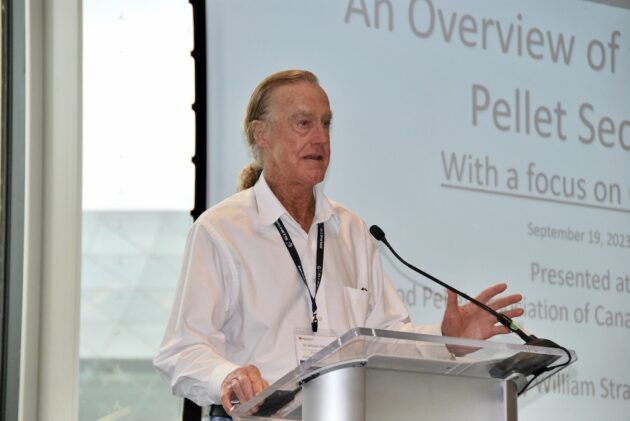
A “mystifying” low domestic demand for bioenergy means Canada still exports more than 90 per cent of the pellets it produces, Strauss said. In 2022, exports reached 3.5 million tonnes, representing a steady growth of the industry. For the first time, Canada’s exports to Japan surpassed its exports to the U.K., with a notable dip in U.K. imports from Canada.
“We expect imports in Japan to continue to grow, potentially doubling in the next four to five years,” Strauss said.
U.S. exports grew significantly last year, up to nine million tonnes, he said. Much of that is going to the U.K., but market share is gaining in Japan as well.
Senerdem, editor of biomass markets for Argus, shared global spot prices trends and demand predictions, noting this year European price volatility eased, reducing wood pellets price advantage over alternative heating fuels. She said they expect to see similar competition with gas and oil over the winter, but pellets may see another advantage by next summer.
Drax Meeting Demand
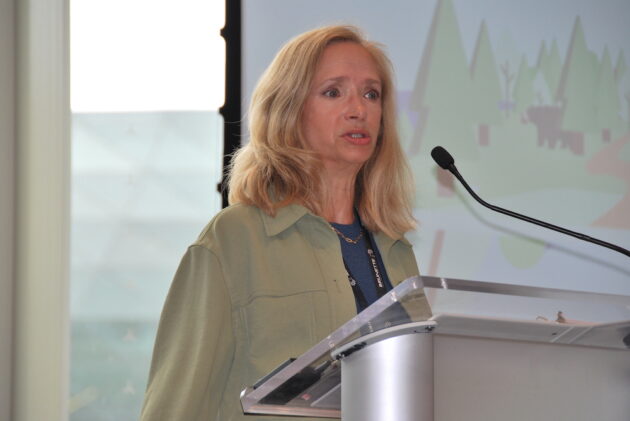
Andrea Johnston, senior vice-president, North America Development for Drax Group, explained that uncertainty in B.C. continues to impact the level of sawmill investment in the province. “We suspect capital allocation will be limited while we deal with the level of uncertainty,” she said. With fewer operating mills, Drax’s B.C. plants will see more uncertainty in terms of residual streams.
“We need both federal and provincial government support through tax incentives and grants,” to offset price fluctuations and uncertainty, Johnston said. The challenge for pellet plants now is accessing the “uneconomic” fibre in the bush.
Speaking on a panel on the next generation of biomass, Bassett outlined Drax’s plans to be carbon negative by 2030 through bioenergy carbon capture and storage (BECCS). The company expects its BECCS operations to be reducing emissions by 14 million tonnes a year – eight million as carbon removal at the Drax Power Station in the U.K., and six million at two BECCS plants in the U.S. South.
The company is targeting final investment decision in 2016 for the two U.S. plants, with operations beginning in 2030. They are evaluating another nine sites for BECCS, each of which would create 5,000 permanent jobs, Bassett said.
Looking to Austria

Christiane Egger, deputy manager of OÖ Energiesparverband – the regional energy agency of Upper Austria – joined WPAC’s conference to share about the agency’s bioheat success over the past few years. More than 1/3 of heating in Upper Austria is bioenergy and many of the world’s biomass boiler manufacturers are from Austria.
The Austrian province saw a significant increase in boiler installations since the pandemic, Egger said, spurred on by factors including Europe’s focus on climate neutrality by moving away from fossil fuels, downtime during the pandemic that encouraged old heating system conversions, and the war in Ukraine and resulting energy crisis in Europe.
Egger says the agency’s strategy to promote bioheat involves “carrots, sticks and tambourines, and a skateboard.” The carrots are incentives through subsidies and grants, the sticks are regulations and legislation, and the tambourines are education and information campaigns. The skateboard was a newer addition to their strategy and represents innovation to speed up the adoption of biomass as rollercoaster of the energy transition continues, she said.
Promoting Diversity
Panelists speaking on the pellet industry’s investment in people and communities through diversity drew parallels between safety and diversity, equity and inclusion (DEI). Julie Griffiths with Shaw Renewables, who heads up WPAC’s Safety Committee, first made the connection when asked what diversity means to her: “I think we need to look at it like we look at safety,” she said, “there is no end point.”
As with safety lessons, Griffiths said, there is always more to learn and draw from when it comes to DEI in a workplace. Inspiration begins with the leaders like herself who should hold themselves accountable and be transparent about challenges like conscious and unconscious biases, and then seek feedback from employees, she said.
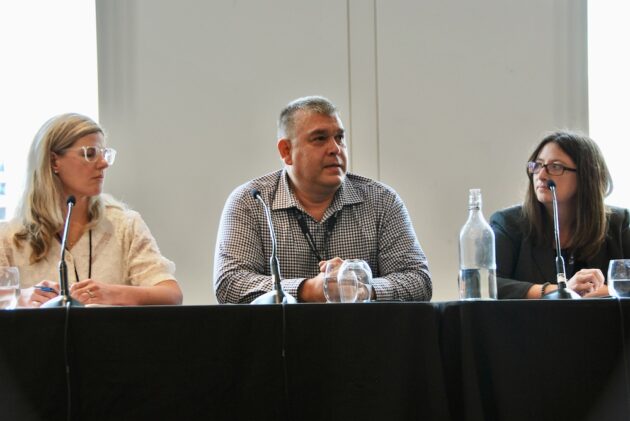
Mark Puglas, director of Indigenous engagement and partnerships at Drax, continued the safety comparison, noting that, similar to a safety culture, employees should feel free to speak up if they see something wrong. Building a culture that respects diversity includes engaging with the workforce to show supervisors and crew that the company is accountable, he said.
Kayleigh Rayner-Brown, director of Obex Risk, offered a pathway for pellet companies that draws from the engineering world: plan, do, check, act. Establish the plan to build DEI into the business, execute the plan, check in with employees, and then integrate the actions into the company. It’s not enough to be aware of diversity, equity and inclusion challenges in our industry and in the workforce, Rayner-Brown said, there needs to be actions.
Swaan, also speaking on the panel, said it’s one thing for a company to have a mission statement around increasing labour diversity, and it’s another for employees to own that. In his experience, he said, spending time with folks on the operation floor will quickly tell you if that mission is effective.
Warning and Inspiration
Keynote speaker Bruce Lourie, president of the Ivey Foundation and climate policy expert, wrapped up WPAC’s 2023 conference with an honest review of Canada’s emissions targets versus results. Among the G7 countries, Canada is well behind counterparts with oil and gas largely exported and those emissions “owned” by us.
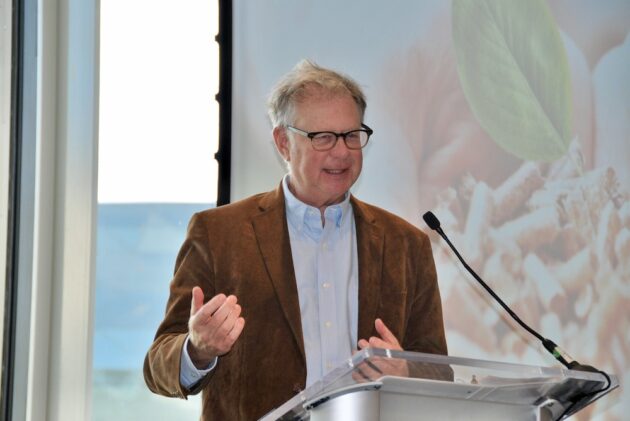
“We have to do more than we’ve committed, and we have to get done what we’ve committed to,” Lourie said. He introduced the concept of “pathways” to achieve net zero, and cautioned against dead-end pathways that serve only to shave emissions off on a high-emitting solution.
Narrative, Lourie said, is a component of all pathways. For the pellet industry, he suggested that policy makers and the public will be more convinced by the importance of the industry to jobs, health, and family, rather than emissions reduction. “That’s what people really care about,” he said, “it’s an economic and community story.”
Lourie self-identified as having more wood-burning appliances than the average Canadian, and suggested bioheat is a story of families gathering around a wood stove, warming their hands. “Nobody is gathering around a heat pump,” he said.
Find session presentations can be found at WPAC 2023 Annual Conference Presentations, and save the date for WPAC Conference 2024 on Sept. 17-18 in Victoria.
Maria Church is with Canadian Biomass.
This article was originally published by Canadian Biomass, a national media brand providing coverage of the emerging biomass, bioenergy and bio-products markets. See CanadianBiomassMagazine.ca for more information.

